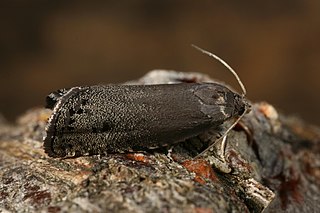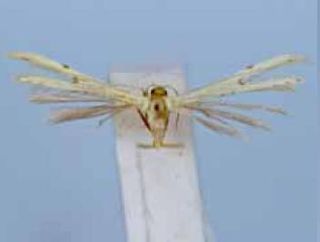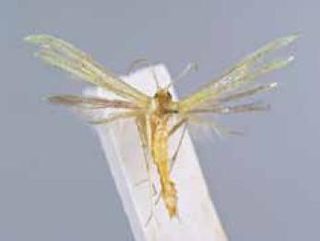
Hyalophora euryalus, the ceanothus silkmoth, is a moth of the family Saturniidae. It is found in the dry intermontane valleys and interior of British Columbia, Canada, south to Baja California in Mexico. The species was first described by Jean Baptiste Boisduval in 1855.

Epiblema strenuana, the stem-galling moth or ragweed borer, is a moth of the family Tortricidae. It is endemic to North America, but was introduced to Australia from Mexico to control the weeds of the family Asteraceae in 1982. It is occasionally misspelled as Epiblema strenuanum.

Cydia millenniana, the larch gall moth, is a moth of the family Tortricidae which galls larch. It is found from Europe to Russia and the Korean Peninsula.
Trifurcula pallidella is a moth of the family Nepticulidae. It is the type species of the genus Trifurcula. It is found from south-eastern Germany (Bayern), east into Bohemia, Moravia, Slovakia, adjacent south-eastern Poland, much of Austria, both along the Danube and east and south of the Alps, extending through the Balkans to southern Greece (Peloponnesus) and Crete, eastwards through Ukraine and Russia to the Volga, and one questionable record from Turkey. To the west it occurs in northern Italy almost reaching France, just extending into Switzerland (Ticino), and throughout Italy to Sicily and Corsica.

Adaina microdactyla is a moth of the family Pterophoridae first described by Jacob Hübner in 1813. Also known as the hemp-agrimony plume, it is found in Africa, Asia and Europe.
Erynnis martialis, the mottled duskywing, is a butterfly of the family Hesperiidae. It is found in most of the eastern United States and in southern Ontario, and southeastern Manitoba. It is listed as a species of special concern and believed extirpated in the US state of Connecticut.
Caloptilia murtfeldtella is a moth of the family Gracillariidae. It is known from Missouri, Washington, California, Kentucky, Michigan and Ohio in the United States.

Adaina simplicius is a moth of the family Pterophoridae. It is found in the United States, Brazil, Costa Rica, Ecuador, Paraguay and Puerto Rico. It was introduced to South Africa for study as a biological control agent for Eupatorium macrocephalum.

Adaina primulacea is a moth of the family Pterophoridae. It is known from Taboga Island in the Gulf of Panama, Costa Rica and southern Florida, United States. It is probably widespread throughout the Neotropics, including the West Indies and Central and South America.

Synanthedon formicaeformis, the red-tipped clearwing, is a moth of the family Sesiidae and can be found in all of Europe, the eastern Palearctic realm, and the Near East. The larvae sometimes form pear-shaped galls on willows. It was first described by Eugenius Johann Christoph Esper in 1783.

Proteoteras willingana, the eastern boxelder twig borer moth, is a moth of the family Tortricidae. It is found in southern Canada and the eastern United States, west through the Great Plains.

Monoptilota is a genus of snout moths. It was described by George Duryea Hulst in 1900. It contains only one species, the lima-bean vine borer moth, which is found in the central and south-eastern parts of the United States.

Dioryctria amatella, the southern pineconeworm moth, is a species of moth of the family Pyralidae. It is found in the south-eastern United States, from Maryland south to Florida and west into Texas.
Caryocolum siculum is a moth of the family Gelechiidae. It is found on central and south-eastern Sicily.

Hierodoris illita is a moth of the family Oecophoridae. It is endemic to New Zealand and is found in both the North and South Islands. However this species has not been recorded at Stewart Island / Rakiura.

Cochylimorpha hilarana is a species of moth of the family Tortricidae. It is found in most of Europe and Asia Minor. The wingspan is 17–23 mm. Adults have been recorded from wing from July to August.
Bucculatrix needhami is a moth in the family Bucculatricidae. It was first described in 1956 by Annette Frances Braun. It is found in North America, where it has been recorded from Florida, Kentucky, Illinois, Maine, New York, Ohio, South Carolina and Texas.

Eucosma metzneriana, the mugwort bell, is a species of moth of the family Tortricidae. It is found on Sicily and in Great Britain, the Netherlands, Belgium, Luxembourg, France, Germany, Denmark, Austria, Switzerland, Italy, the Czech Republic, Slovakia, Slovenia, Hungary, Bulgaria, Romania, Poland, Sweden, Finland, the Baltic region, Ukraine, Russia, North Africa, Transcaucasia, Asia Minor, Iran, Kazakhstan, Kyrgyzstan, Mongolia, China, Korea and Japan.

Eucosma aspidiscana, the golden-rod bell, is a species of moth of the family Tortricidae. It is found in China, Mongolia, Korea, Japan, Russia, North Africa and most of Europe. The habitat consists of woodlands, downland, waste grounds and cliffs.
Hierodoris sesioides is a species of moth in the family Oecophoridae. It is endemic to New Zealand and is known from its type locality of Esk State Forest in the Hawkes Bay. The host species is Spohora tetraptera, a kōwhai species. The larvae feed internally in woody galls on the stems of this plant. This species is classified as "Data Deficient" by the Department of Conservation.













